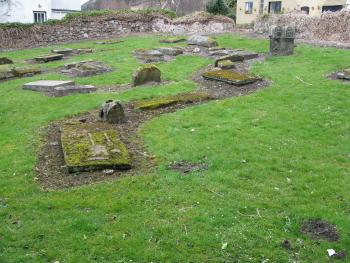- Navigation:
- Back to the Corpus index page
- RSS
Tillicoultry Parish Church
Tillicoultry Old Churchyard, from south east
- Dedication: St Serf
- Diocese of Dunblane
- County of Clackmannanshire
- Clackmannan Council
- c. 923 975 ?
Summary description
Nothing that is identifiable with certainty survives of the medieval parish church, but it is known to have been within a graveyard to the south-east of Tillicoultry House, which is now surrounded by modern housing.
Historical outline
Dedication: St Serf
The first mention of the church of Tillicoultry occurs in 1189x1194 when King William granted it, with its teinds, land and other properties and rights, to Cambuskenneth Abbey.(1) This grant was confirmed the following year in a bull of Pope Celestine III.(2) Around the same date, Bishop Simon of Dunblane annexed the church and its fruits for the uses of the canons, a position confirmed by his successors.(3) In his confirmation, Bishop Osbert in c.1230 added the concession that the canons could serve the church with chaplains. Certainly, the church is not listed as a separate entity in Bagimond’s Rolls, its taxation presumably being subsumed within the figure for Cambuskenneth. Following from the papal bull which gave the bishop of Dunblane the right to one quarter of the teinds of all the churches in his diocese,(4) Bishop Clement had attempted to collect this right from the churches in Cambuskenneth’s possession. This move, however, had resulted in litigation with the abbey which was settled in January 1240 when the bishop conceded his right to the teinds.(5) With the appropriation confirmed, the cure seems to have been served mainly by chaplains and the church remained annexed to Cambuskenneth at the Reformation.(6)
In the early fourteenth century, Neil, son of Colin Campbell, lord of Tillicoultry, endowed the parish church of St Serf of Tillicoultry with ten acres of arable and a team of oxen to plough it.(7) The grant which Colin had given for the souls’ ease of himself, his family, ancestors and successors, was confirmed by King Robert I in March 1315/6, but for the souls of himself, ancestors and successors.(8)
Notes
2. Cambuskenneth Registrum, no 25.
3. Cambuskenneth Registrum, nos 124, 217, 221.
4. Theiner, Vetera Monumenta, no CXI.
5. Cambuskenneth Registrum, no 125.
6. Kirk (ed.), Book of Assumptions, 538, 543, 545, 546.
Architectural description
The entry in the Old Statistical Account, published in 1795, states that the old parish church and manse were in the graveyard in the vicinity of Tillicoultry House (itself now demolished), and the first edition of the Ordnance Survey shows the house immediately to the north-west of the graveyard. The slope to the south of the graveyard was called Kirk Hill. The old church was replaced by a new one on a more convenient site, on Dollar Road, which the Statistical Account says was built in 1773; however, the new churchyard has at least one monument dating from the late seventeenth century, suggesting that the move took place earlier, perhaps to enhance the privacy of the occupants of Tillicoultry House. The eighteenth-century church was in turn superseded by the church which remains in use, and which was built to the designs of William Stirling in 1827-9.
The old graveyard was evidently in use for burials from at least the twelfth century on the evidence of two coped monuments, one of which has the tegulation usually associated with hogback stones; the other of those stones is probably later, and has been re-used to mark a post-Reformation burial. The location of the church within the graveyard is unknown, but it is worth noting that the part of the north boundary wall to the west of the gateway is thicker than might be expected for such an enclosure wall, and the possibility cannot be ruled out that it is a relic of the church. One possible fragment from the church in the churchyard is what appears to be a stone from the apex of a coped gable, in which there is the socket for a cross or finial; however, the stone is now so weathered that it is difficult to determine if it is of medieval or later date.
Bibliography
Cowan, I.B., 1967, The parishes of medieval Scotland, (Scottish Record Society), Edinburgh, 197.
Gibson, W., 1883, Reminiscences of Dollar, Tillicoultry and other districts adjoining the Ochils, Edinburgh, 155.
Gifford, J. and Walker, F.A., 2002, The Buildings of Scotland, Stirling and Central Scotland, New Haven and London, 770-1.
Hay, G., 1957, The architecture of Scottish post-Reformation churches, Oxford, 253.
Kirk, J., 1995, The books of assumption of the thirds of benefices, (British Academy) Oxford, 538, 543, 545, 546.
New Statistical Account of Scotland, 1845, Edinburgh and London, viii (Clackmannan), 683.
Regesta Regum Scottorum, Acts of William I (1165-1214), 1971, Edinburgh, no 324.
Registrum monasterii S. Marie de Cambuskenneth, 1872, ed. W. Fraser, (Grampian Club), Edinburgh, nos, 25, 124, 125, 217, 221, 222, 223.
Reports on the state of certain parishes in Scotland, 1835, ed. A. Macdonald, (Maitland Club), Edinburgh, 27.
Royal Commission on the Ancient and Historical Monuments of Scotland, Canmore database.
Royal Commission on the Ancient and Historical Monuments of Scotland, 1933, Inventory of Fife, Kinross and Clackmannan, Edinburgh, 325-6.
Statistical Account of Scotland, 1791-9, ed. J. Sinclair, Edinburgh, xv (1795), 207.
Vetera Monumenta Hibernorum et Scotorum Illustrantia, 1864, ed. A. Theiner, Rome, no cxi.
Map
Images
Click on any thumbnail to open the image gallery and slideshow.









